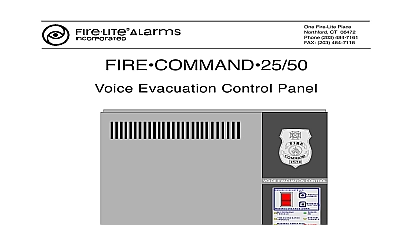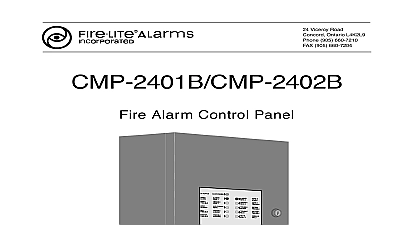Fire-Lite IPDACT Installation Manual

File Preview
Click below to download for free
Click below to download for free
File Data
| Name | fire-lite-ipdact-installation-manual-3069785124.pdf |
|---|---|
| Type | |
| Size | 2.99 MB |
| Downloads |
Text Preview
Communicator Manual DM373 I 2.0 2007 of contents 1.3 1.1 1.2 Introduction I 1 Introduction I 1 1 Scenario I 1 Mode I 3 1.2.1 Monitoring I 3 sending I 5 1.2.2 features I 6 IPDACT Description II 7 1 General Description II 7 2 LEDs II 10 3 Jumper II 11 4 Connection points to the Control Panel and external II 11 5 LAN II 13 6 Console II 13 Installation and cabling III 17 1 Installation III 17 1.1 Assembly Instructions for the IPDACT box III 19 2 Wiring III 20 2.1 Wiring for UL Listed Fire Installations III 20 scheme III 20 instructions III 22 Configuration IV 27 1 Configuration modes IV 27 2 DHCP IV 27 3 Telephonic Console IV 29 3.1 Configuration IV 30 3.1.1 Default Configuration IV 32 3.1.2 Register description IV 32 3.1.3 Minimum configuration for the installer IV 38 3.1.4 Configuration Example IV 39 4 Asynchronous Console IV 41 4.1 Accessing the console IV 41 2.1.1 2.1.2 4.2 Main Menu IV 41 generic configuration IV 42 4.3 4.4 Monitoring configuration and sending of alarms IV 42 4.5 Quick Configuration IV 43 4.6 Monitoring IV 44 5 Telnet IV 46 Appendix V 47 1 UL Compliance V 47 2 Control Panels V 47 3 Technical Specifications V 48 manufacturer reserves the right to introduce changes and to the appropriate features of both the hardware and software of this product modifying the specifications included in manual without prior notice Chapter Introduction 1 IPDACT Introduction IP module IPDACT is a device which panel carries out three basic tasks when connected to a security send over an IP network the alarm information sent by the panel which this is connected check the connectivity between the control panel and the alarms center cases where it is not possible to transmit over the IP network the will stop intercepting the alarms from the panel At this the alarms will be sent over the telephone line IPDACT operates together with the Teldat VisorALARM device located the alarm receiver center This behaves as an alarm receiver which the alarms through an IP network instead of the traditional public telephone network and sends them through a serial port to automation in order to be processed Additionally this receives monitoring from multiple IPDACT and generates the corresponding alarm in where communication fails with one or more of these For further on how the IP Dm 357 I receiver operates please see 1.1 User Scenario traditional security scenario consists of a control panel CP located in the environment and an alarm receiver center ARC located in the security control center The CP contains a group of sensors which trigger series of alarms or events which when produced are sent to the ARC to be between the above is traditionally carried out over the line so that both ends can initiate a call to the remote end the CP in to notify events and the ARC for bi directional tasks activation and general control Introduction 2.0 communication protocol varies depending on the manufacturers who tend to use their own solutions The IPDACT CP is placed as the first connection element to the PSTN so that it can the customer telephone line supports Contact ID Panel Telephony Network Receiver SW MAS MicroKey Receiver Center 1 Traditional security scenario the general user scenario the IPDACT device is located in the client next to the control panel intercepting the telephone line This is in Figure 2 The arrow in the figure demonstrates the preferred to send alarms from the CP here the telephone line is used as a backup case there is a communication malfunction in the IP network por M A Berrojo 10 Mbps Telephony por M A Berrojo 10 Mbps por M A Berrojo por M A Berrojo Alarm Alarm Receiver SW MAS MicroKey Receiver Center Panel I P 2 Teldat VisorALARM and IPDACT operating scenario firmware release 2.2 onwards the IPDACT has a new functionality giving rise to a third possible scenario network backup In the scenario where communication fails between the device and the the IPDACT hands over the communications to the control panel With new functionality the IPDACT tries to open communications with a second the backup VisorALARM Only in cases where there are problems this second device does the control panel take over Meanwhile even in state the IPDACT continues to try and communicate with the ARC until of the VisorALARMs responds Module Introduction UL compliance installations the IPDACT must have firmware 4.0 3 Network backup function scenario 1.2 Operation Mode IP Module IPDACT connected to the client control panel carries out two sending alarms from the panel and monitoring the connection with the receiver The network backup option has implications in connection The alarms reception center is composed of two VisorALARM one main and the other backup The IPDACTs release 2.2 onwards had their monitoring procedures modified in order to contemplate the of two devices in the central 1.2.1 Monitoring IPDACT is a device that intercepts the control panel telephone with two aims firstly to detect when the panel sends an alarm in to capture it and retransmit over the connected IP network and secondly allow the telephone line to be used at the same time as sending alarms interception of the telephone line takes place ONLY in cases where with either of the Teldat VisorALARM devices has been verified IPDACT VisorALARM connectivity is checked through a traffic monitor the IPDACT periodically sends and to which the main Teldat responds Through configuration the main VisorALARM IP Module Introduction is given to the IPDACT and is the primary communication option backup VisorALARM IP address is also


